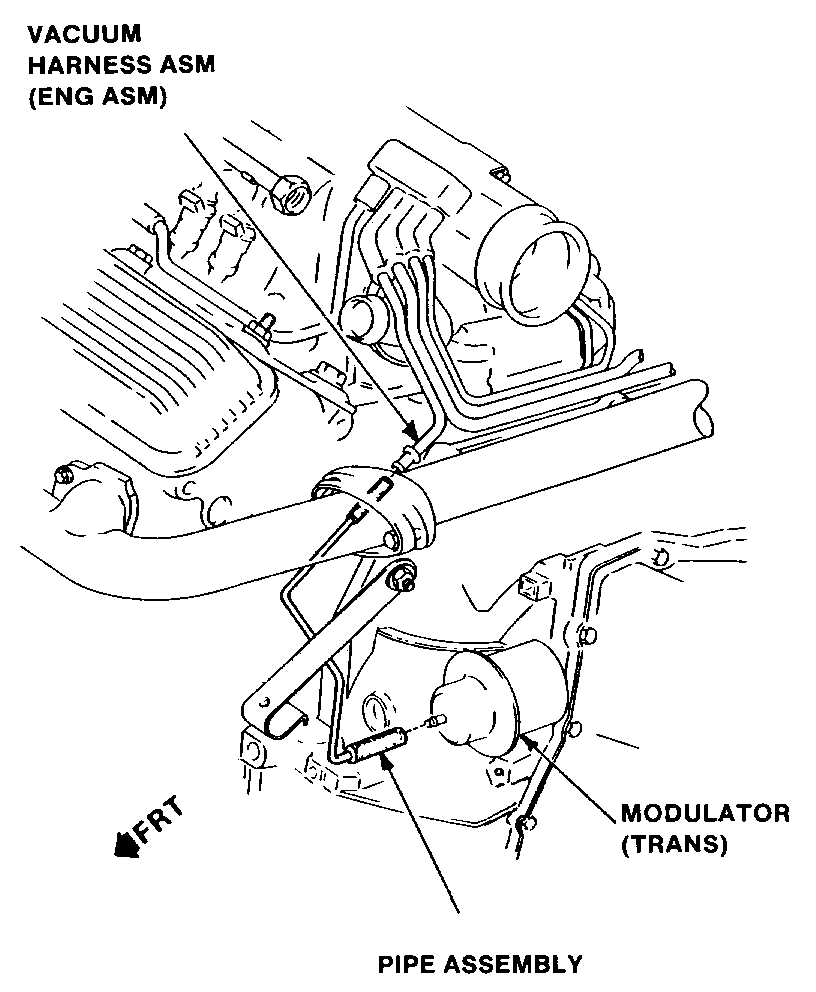440T4 TRANSAXLE FAILURE PINCHED VACUUM LINES

1984-85 CUTLASS CIERA & 1985 98 MODELS EQUIPPED WITH 3.8L (VIN CODE 3) V-6 ENGINES & THM 440-T4 TRANSAXLES
A repeat THM 440-T4 transaxle failure may be due to pinched or kinked vacuum lines causing low oil pressure. Visual inspection of lines is inadequate to detect this condition. To diagnose this condition, connect a vacuum gage at the vacuum modulator by use of a tee with adequate hose length to observe the gage. With engine running and throttle closed, vacuum at modulator should be 13-17 in. Hg. When the throttle is opened, vacuum drop should be IMMEDIATE. A slow vacuum drop when the throttle is opened indicates a kinked or pinched vacuum line. Vacuum retained in the modulator will reduce line pressure and may result in second clutch distress.
In mid-January, the aspirator/solenoid was eliminated and replaced with a solid steel line to supply vacuum to the modulator. See Figure 1. If a condition of inadequate vacuum supply to the modulator exists or if the aspirator solenoid should fail or you are experiencing second gear starts or excessively firm shifts, it is recommended that a solid steel line minus the aspirator be installed as shown in Figure 1.
ALSO, WHENEVER AN EXCHANGE UNIT OR A REMANUFACTURED TRANSAXLE IS INSTALLED IN ONE OF THESE VEHICLES THAT STILL HAS THE ASPIRATOR SYSTEM ON IT, IT SHOULD BE REMOVED AND THE NEW STEEL LINE INSTALLED.
The electrical connector to the aspirator system solenoid should be taped back out of the way.
A formed steel line, two pieces of 7/32" vacuum hose and a new emission label are available from WDDGM under the following part numbers:
Model Part Number ----- ---------- Cutlass Ciera 25527722 Ninety-Eight 25527723
WARRANTY INFORMATION
Labor Operation Labor Hours Trouble Code --------------- ----------- ------------ T5096 .4 92

General Motors bulletins are intended for use by professional technicians, not a "do-it-yourselfer". They are written to inform those technicians of conditions that may occur on some vehicles, or to provide information that could assist in the proper service of a vehicle. Properly trained technicians have the equipment, tools, safety instructions and know-how to do a job properly and safely. If a condition is described, do not assume that the bulletin applies to your vehicle, or that your vehicle will have that condition. See a General Motors dealer servicing your brand of General Motors vehicle for information on whether your vehicle may benefit from the information.
